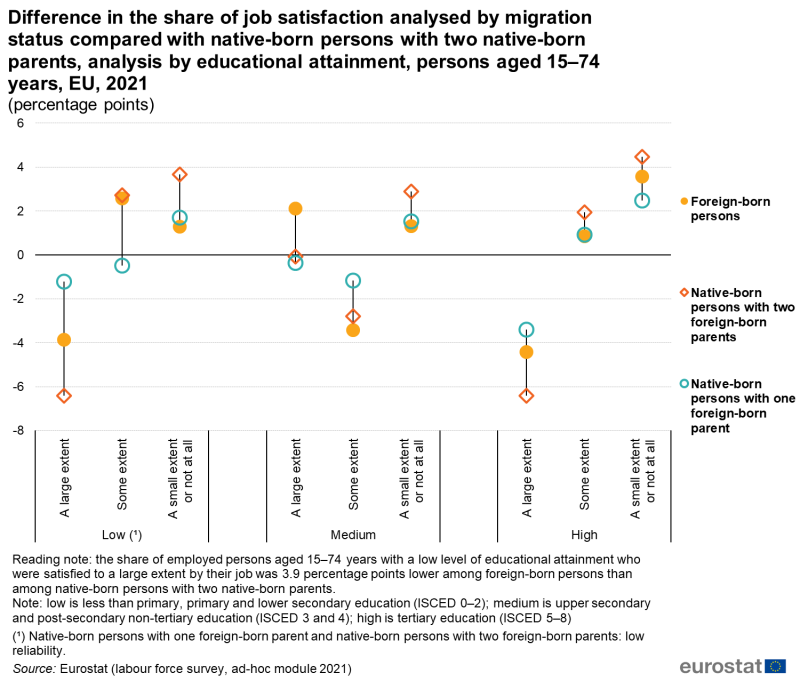Foreign-born people and their descendants - level of job satisfaction
Data extracted October 2022.
No planned article update.
Highlights
Native-born persons with two native-born parents in the EU were least likely to be slightly satisfied or not at all with their job in 2021. Native-born persons with two foreign-born parents were most likely to be slightly satisfied or not at all.
Among the EU Member States, the highest share of foreign-born persons who were slightly satisfied or not at all with their job in 2021 was in the Netherlands (16.8 %), the lowest share was in Hungary (3.1 %).
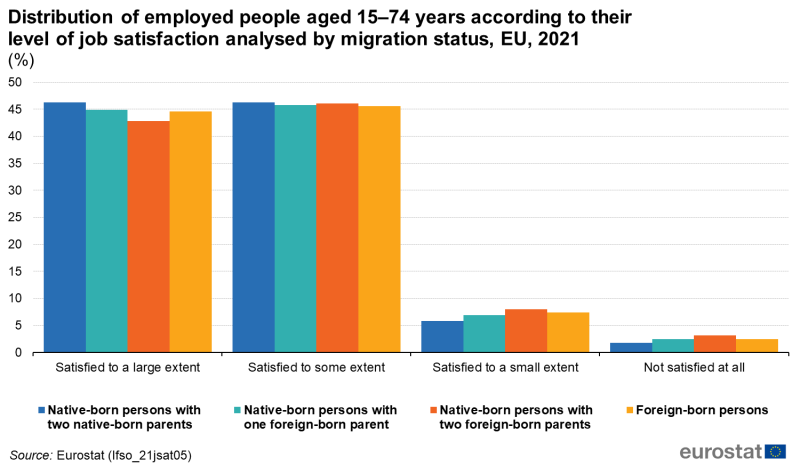
(%)
Source: Eurostat (lfso_21jsat05)
This article is one of a set of statistical articles concerning foreign-born people and their immediate descendants in the EU. This article forms part of an online publication. It presents statistics on the level of job satisfaction. The data used in the article come from the 8-yearly regular module of the Labour Force Survey (EU-LFS) on the labour market situation of migrants and their immediate descendants held in 2021. The presented results cover the European Union (EU) as a whole and its individual Member States, as well as two EFTA countries (Norway and Switzerland). The focus is on people living in private households aged 15–74 years.
Full article
Overview
Persons living in private households can be categorised in terms of their migration status as:
- native-born with two native-born parents,
- native-born descendants of at least one foreign-born parent,
- native-born descendants of one foreign-born parent,
- native-born descendants of two foreign-born parents,
- foreign-born persons.
An article on the main characteristics of people by migration status (based on the EU-LFS data) provides information on the relative size of these categories. Two further articles provide information on labour market conditions and labour market indicators.
This article focuses on employed persons only. Four levels of job satisfaction are identified and shown in Figure 1. For the remaining analyses, two of these are combined:
- satisfied to a large extent,
- satisfied to some extent,
- satisfied to a small extent or not at all, combining satisfied to a small extent and not satisfied at all.

(%)
Source: Eurostat (lfso_21jsat05)
When analysed by migration status, few differences can be seen in the structure in 2021 of the EU's employed population in terms of job satisfaction. In particular, the shares of employed persons who were satisfied to some extent varied little by migration status. Among the other levels of job satisfaction, the following differences can be noted.
- For native-born persons with two native-born parents, the share of employed persons who were satisfied to a large extent was higher than for any of the three other migration status categories, while the shares of satisfied to a small extent or not at all were the lowest.
- For native-born persons with two foreign-born parents, the share of employed people who were satisfied to a large extent was lower than for any of the other migration status categories, while the shares of satisfied to a small extent or not at all were the highest.
- The job satisfaction shares for native-born persons with one foreign-born parent and for foreign-born persons were similar to each other. These shares were between those for native-born persons with two native-born parents and those for native-born persons with two foreign-born parents.
Native-born persons with two native-born parents were generally less likely to be slightly satisfied or not at all with their job
The analysis in the rest of this part of the article focuses on the two lowest categories of job satisfaction: people who were satisfied to a small extent or not at all with their job. The share of native-born persons with two native-born parents who were satisfied to a small extent or not at all with their job was generally lower than the equivalent shares among the three other migration status categories. In 2021, this was observed in the EU regardless of age, level of educational attainment, professional status and broad occupational category. The only exception was for foreign-born males: the share who were satisfied to a small extent or not at all with their job was slightly lower than for native-born persons with two native-born parents.
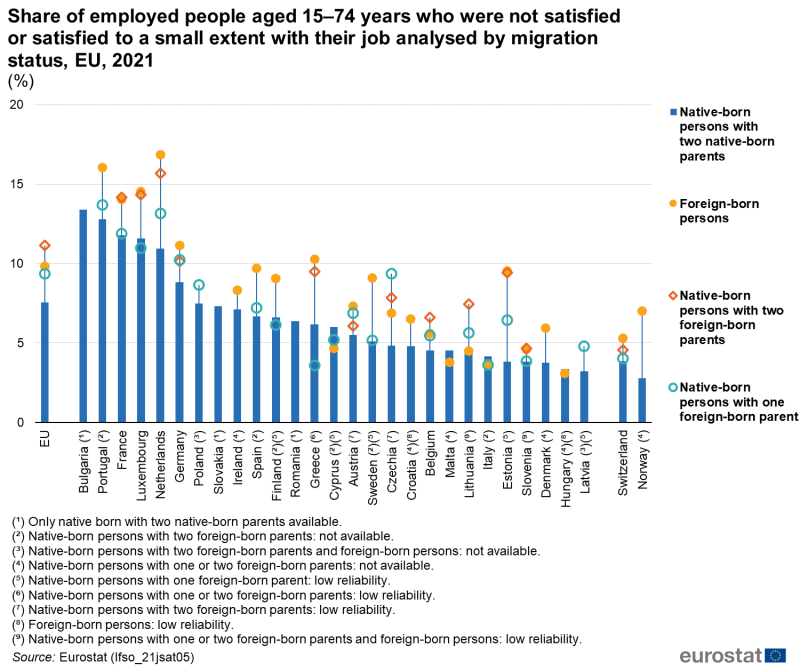
(%)
Source: Eurostat (lfso_21jsat05)
In the EU, 7.5 % of employed native-born persons with two native-born parents were satisfied to a small extent or not at all with their job in 2021. By contrast, this share was 9.4 % among native-born persons with one foreign-born parent, 9.8 % among foreign-born person and 11.1 % among native-born persons with two foreign-born parents.
In most EU Member States, native-born persons with two foreign-born parents or foreign-born persons were most likely to be slightly satisfied or not at all with their job
For 11 EU Member States, data for all four migration status are available for the share of employed persons who were satisfied to a small extent or not at all with their job in 2021 (see Figure 2).
- Nine Member States reported that native-born persons with two native-born parents had the lowest shares of employed persons who were satisfied to a small extent or not at all with their job. In Luxembourg and Greece (low reliability), native-born persons with one foreign-born parent had the lowest share.
- Six Member States reported that foreign-born persons had the highest share of employed persons who were satisfied to a small extent or not at all with their job. In Belgium, France, Lithuania (low reliability) and Slovenia (low reliability), native-born persons with two foreign-born parents had the highest share. In Czechia, native-born persons with one foreign-born parent had the highest share.

(%)
Source: Eurostat (lfso_21jsat05)
Figure 3 compares the share of employed persons who were satisfied to a small extent or not at all with their job for native-born persons with at least one foreign-born parent with the equivalent share for foreign-born persons, data are presented for 2021.
- For the EU, the shares were similar, 9.8 % for foreign-born persons and 10.0 % for native-born persons with one or two foreign-born parents. As these shares were similar, the EU's plot is close to the diagonal line in the figure.
- In 13 EU Member States, the difference between the two shares was less than 2.5 percentage points(pp):
- in Czechia, Cyprus (low reliability), Lithuania (low reliability), Ireland (low reliability) and Belgium, the share was somewhat higher for native-born persons with at least one foreign-born parent;
- in Slovenia (low reliability), Italy, Austria, Germany, France, Luxembourg, Estonia and Croatia (low reliability), the share was somewhat higher for foreign-born persons.
- Member States with larger differences between the two shares all had higher shares for foreign-born persons, this was observed in the Netherlands, Sweden, Spain, Greece and Finland (low reliability).
Analysis by age, sex and educational attainment
Figures 4 to 8 show the difference in the share of each level of job satisfaction for three migration statuses (compared with that of native-born persons with two native-born parents). For each migration status, the shares of people with each level of job satisfaction have been subtracted from the equivalent share for native-born persons with two native-born parents (giving a result in percentage points(pp)). A positive/negative difference indicates a higher/lower share with the particular level of job satisfaction than for native-born persons with two native-born parents.
Among employed persons aged 20–64 years, native-born persons with two foreign-born parents or foreign-born persons were less likely to be satisfied to a large or some extent with their job
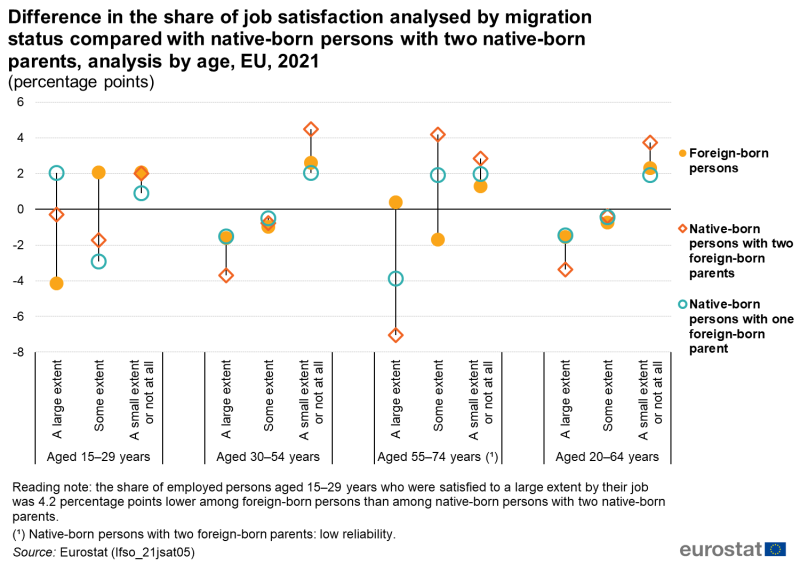
(percentage points)
Source: Eurostat (lfso_21jsat05)
Figure 4 provides an analysis of job satisfaction for the EU for 2021, contrasting various age groups. As well as separating the full age coverage into three age groups (15–29, 30–54 and 55–74 years), it also provides an analysis for the age group 20–64 years. This age group is of particular interest as it is the focus for employment analyses in the Action Plan on Integration and Inclusion 2021–2027.
- Regardless of the age group, native-born persons with one or two foreign-born parents and foreign-born persons had higher shares of employed persons with small or no job satisfaction.
- Native-born persons with one or two foreign-born parents and foreign-born persons generally had lower shares of employed persons who were satisfied to a large or some extent with their job. This was the case for all of these migration status for people aged 20–64 years and for those aged 30–54 years, however, there were some exceptions for younger and older employed persons.
- Among younger people (aged 15–29 years), a larger share of foreign-born persons were satisfied to some extent and a larger share of native-born persons with one foreign-born parent were satisfied to a large extent.
- Among older people (aged 55–74 years), a larger share of foreign-born persons were satisfied to a large extent and a larger share of native-born persons with one or two foreign-born parents were satisfied to some extent.

(percentage points)
Source: Eurostat (lfso_21jsat05)
Foreign-born males were less likely to be satisfied to a small extent or not at all with their job
An analysis of job satisfaction by sex is presented in Figure 5 for the EU for 2021.
- A smaller share of native-born females with one or two foreign-born parents and foreign-born females were satisfied to a large or some extent with their job. For native-born females with one or two foreign-born parents, the differences in the shares (compared with native-born females with two native-born parents) with some job satisfaction were small. Consequently, a larger share of native-born females with one or two foreign-born parents and foreign-born females had small or no job satisfaction.
- Among males, the situation was less clear.
- Native-born males with one or two foreign-born parents and foreign-born males had lower shares of persons employed who had a large extent of job satisfaction.
- Native-born males with one or two foreign-born parents also had lower shares of employed people who had some job satisfaction. Among foreign-born males, this share was higher than among native-born males with two native-born parents. The shares were quite similar for all migration status.
- The reverse situation was observed for the share of employed males who had small or no job satisfaction: the shares for native-born males with one or two foreign-born parents were higher, while the share for foreign-born males was slightly below that for native-born males with two native-born parents.
Foreign-born people with a medium level of educational attainment were more likely to be satisfied to a large extent with their job
Figure 6 provides an analysis of job satisfaction for people by three levels of educational attainment: low (ISCED levels 0–2), medium (ISCED levels 3 and 4) and high (ISCED levels 5–8). For low and high education levels, the differences between migration status categories in the level of job satisfaction were quite similar in the EU in 2021.
- For native-born persons with one or two foreign-born parents and for foreign-born persons, the shares who were satisfied to a large extent with their job were relatively lower.
- The reverse was generally observed for employed persons who were satisfied with their job to some extent or to a small extent/not at all: native-born persons with one or two foreign-born parents and foreign-born persons recorded relatively higher shares. The one exception was the slightly lower share observed for native-born persons with one foreign-born parent who were to some extent satisfied with their job.
For the medium education level, the situation in the EU in 2021 was similar (to that for the low and high education levels) for the shares who were satisfied with their job to a small extent or not at all, but otherwise different.
- For native-born persons with one or two foreign-born parents, the shares who were satisfied to a large extent with their job were slightly lower than the equivalent share for native-born persons with two native-born parents. For foreign-born persons, this share was notably higher.
- For native-born persons with one or two foreign-born parents and for foreign-born persons, the shares who were satisfied to some extent with their job were relatively low.
Analysis by professional status and occupation
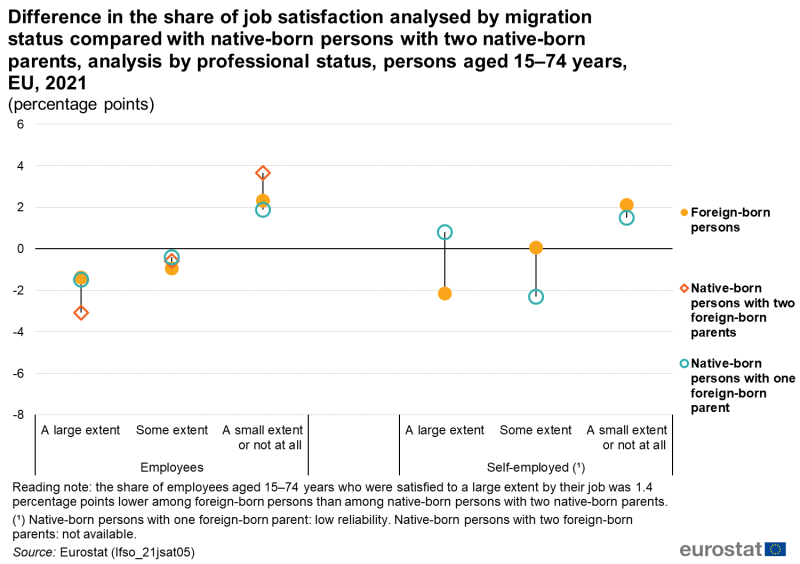
(percentage points)
Source: Eurostat (lfso_21jsat05)
Native-born persons with one foreign-born parent who were self-employed were more likely to be satisfied to a large extent with their job
For the analysis of job satisfaction by professional status in the EU in 2021 (see Figure 7), two professional status are considered: employees and self-employed persons. As for earlier analyses, one common point is that both professional status categories studied had higher shares of people with small or no job satisfaction among native-born persons with one or two foreign-born parents and foreign-born persons than among native-born persons with two native-born parents.
- Among employees, a smaller share of native-born persons with one or two foreign-born parents and foreign-born persons were satisfied to a large or some extent with their job. Concerning those with some job satisfaction, the differences in the shares were relatively small.
- For self-employed persons, data are not available for native-born persons with two foreign-born parents. Native-born persons with one foreign-born parent (low reliability) had a higher share of self-employed persons with a large extent of job satisfaction but a lower share with some job satisfaction. The reverse situation was observed for foreign-born self-employed persons, although the difference in the share (compared with native-born persons with two native-born parents) for those with some job satisfaction was small.

(percentage points)
Source: Eurostat (labour force survey, ad-hoc module 2021)
Regardless of broad occupational category, native-born persons with one or two foreign-born parents and foreign-born persons were less likely to be satisfied to a large extent with their job
The final analysis (see Figure 8) of EU data for 2021 considers two broad categories of occupations defined by ISCO: managers, professionals and technicians (ISCO Major groups 1–3) and other occupations (ISCO Major groups 0 and 4–9).
- For both broad categories of occupations, the shares of people with small or no job satisfaction among native-born persons with one or two foreign-born parents and foreign-born persons were higher than among native-born persons with two native-born parents.
- The reverse situation was observed for both broad categories of occupations concerning the shares of people who were satisfied to a large extent with their job: the shares among native-born persons with one or two foreign-born parents and foreign-born persons were lower.
- Regardless of broad category of occupations, the share of people who were satisfied to some extent with their job was lower for foreign-born persons than that of native-born persons with two native-born parents.
- Among native-born persons with one or two foreign-born parents, a larger share of managers, professionals and technicians had some job satisfaction, whereas for other occupations, this share was lower.
Source data for tables and graphs
Data sources
EU Labour Force Survey (EU-LFS) is the largest European household sample survey. The EU-LFS covers the resident population, defined as all people usually residing in private households. Usual residence means the place where a person normally spends the daily period of rest, regardless of temporary absences for purposes of recreation, holidays, visits to friends and relatives, business, medical treatment or religious pilgrimage. The data for the EU are aggregated results for the 27 EU Member States.
Limitations of the data
EU-LFS only covers private households. Persons living in collective households are excluded from the target population. Due to the sampling nature of the EU-LFS, some data are with low reliability or not shown due to very low reliability or confidentiality. Such cases are duly marked in the footnotes below the figures and tables.
Main concepts
- An employed person is someone aged 15-89 years who, during the reference week of the survey, performed work – even if just for one hour a week – for pay, profit or family gain. Also included are people who were not at work but had a job or business from which they were temporarily absent.
- An employee is a particular type of employed person. Employees work for a public or private employer and receive compensation in the form of wages, salaries, payment by results, or payment in kind> Non-conscript members of the armed forces are also included. Employees are not self-employed or contributing family workers.
- Self-employed persons are defined as persons who work in their own business (including professional practices, farms, shops and other businesses) for the purpose of earning a profit.
- Educational attainment refers to the highest level of education successfully completed. Educational levels are defined and classified in the international standard classification of education (ISCED). The levels of education used in this article are based on ISCED 2011. A low level of education refers to ISCED levels 0–2 (less than primary, primary and lower secondary education), a medium level refers to ISCED levels 3 and 4 (upper secondary and post-secondary non-tertiary education) and a high level refers to ISCED levels 5–8 (tertiary education).
- Occupations of employed persons are defined and classified in the international standard classification of occupations (ISCO). The occupations used in this article are based on ISCO-08.
Calculation of shares in totals
Most of the tables and figures in this article present shares of a total. Figure 1 shows the complete distribution of employed people according to their level of job satisfaction. While most survey respondents provided information on their level of job satisfaction, some did not. Those who did not are classified either as not stated (non-response) or as unknown. The calculation of shares/distributions is based on a total excluding the number of people who did not answer this question. The distributions by level of job satisfaction therefore sum to 100.0 %.
Context
Successful integration may lead to economic and social benefits for migrants and for the society where they live. More information on the policies and legislation in force in this area can be found in an introductory article on migrant integration statistics.
Direct access to
Online publications
Methodology
- LFS ad hoc modules on migrants (mii_lfso)
- LFS series – Detailed annual survey results (ESMS metadata file – lfsa_esms)
- EU labour force survey
